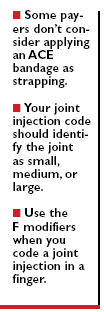Article
Coding Consult
Sprains and joint injections

Sprains: Remember to charge for supplies
When you treat a sprain, you can get reimbursed for almost every detail of your services. To see how this works, say you treat a new patient's sprained thumb that he injured while playing basketball. You take his medical history, examine the thumb, and then wrap it with an ACE bandage to immobilize it.
And remember to bill for the bandage you used to wrap the thumb, says Catherine Brink, a certified coder and president of HealthCare Resource Management in Spring Lake, NJ. Use codes A6448 (light compression bandage, elastic, knitted/woven, width less than 3 in., per yard) or A6450 (. . . width greater than or equal to 5 in., per yard).
Another tip: If you take an X-ray on the patient's thumb, make sure you report the X-ray code (73120-73140). If, during the same visit, you performed an E&M service for the new patient, report the appropriate code (99201-99205) and, depending on the insurer, attach modifier –25 (significant, separately identifiable evaluation and management service by the same physician on the same day of the procedure or other service), Brink says. Modifier –25 could prevent a denial because it will signal your payer that the E&M was separate from the sprain treatment.
If the same patient returns because his thumb is tingling and numb, be careful which diagnosis code you choose. You should list the late-effects diagnosis code before the code for the sprain, because the numbness is what you're assessing during this second visit, Acevedo says. Use ICD-9-CM code 905.7 (late effect of sprain and strain without mention of tendon injury) and list 842.12 second, she says.
Joint injections: Correctly identify the joint
Another sports injury treatment you might perform is a joint injection. Make sure that your code correctly identifies the joint as small, medium, or large, Brink says. For example, the arthrocentesis codes (20600, 20605, and 20610) identify finger and toe joints as small joints, while shoulder, hip, and knee joints are large joints, she says.
Remember to report the "J" code to charge for the drug. You need to specify in the medical record which drug-and the exact dosage-you inject. For instance, say your notes read "Gave patient Depo-Medrol injection," but they don't document a specific dosage. If you reported J1040 (injection, methylprednisolone acetate, 80 mg), you wouldn't have any documentation to support the claim in an audit.
Say you treat a new patient for her elbow pain. You drain fluid from her elbow, inject 20 mg of Depo-Medrol, and tell her to return for another injection if her elbow doesn't improve.
Report 20605 (arthrocentesis, aspiration and/or injection; intermediate joint or bursa [e.g., temporomandibular, acromioclavicular, wrist, elbow or ankle, olecranon bursa]) for the draining and injection. You can use code J1020 (injection, methylprednisolone acetate, 20 mg) for the injectable and 726.33 (olecranon bursitis) for your diagnosis of bursitis of the elbow.





